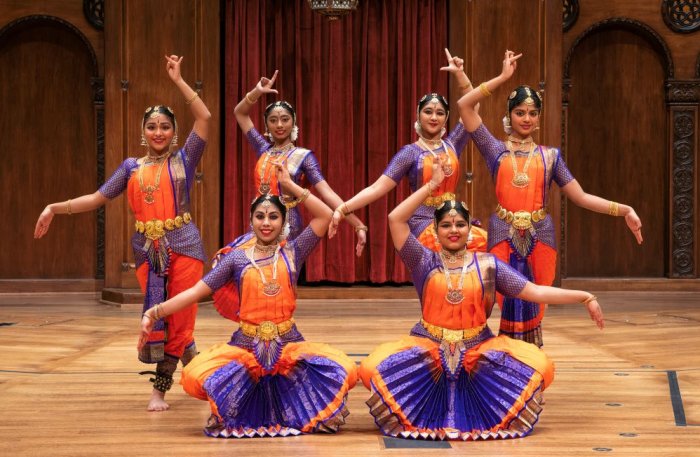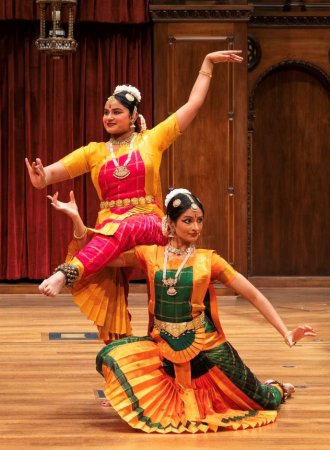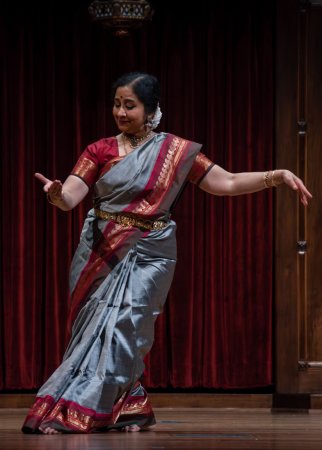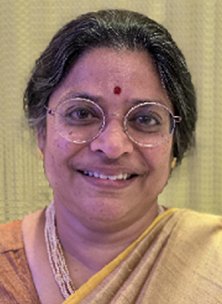
|   |

|   |
Margam - A dynamic visualization - Dr. Ganga Lakshmi Srinivas e-mail: gangalakshmi@gmail.com December 3, 2023 Over the years, as Bharatanatyam has become entrenched in the Indian experience in America, artistes increasingly produce explorations of social and cultural boundaries, or push to make this most tangible and structured of art forms represent the most abstract concepts. The tradition of the margam of a series of pieces not necessarily strung into a theme and set over a century ago by the talented Tanjore Quartet is to be seen more typically only at arangetrams, as young dancers make their debut. It was thus so refreshing to watch a margam in which experienced dancers took the stage for the emotionally demanding varnam and javali. Guru Sujatha Srinivasan and her talented Shri Kalaa Mandir troupe presented a traditional margam at Case Western University's Maltz Performing Arts Center in Cleveland, Ohio on a beautiful fall weekend in November.  Traditionally, the alarippu is supposed to represent the 'blossoming' of the dancer. It is challenging to hold the audience when all you can move for a while are your eyes. The senior dancers Sudhiksha Ramesh, Srishti Ithychanda, Sneha Upadhyayula, Yuvha Karthikeyan and Arushi Shinde were an excellent choice to showcase their mastery of dhrishti bheda and the finer movements of their hands and arms. The movements of the misra chapu talam piece represented a peacock, a small innovation that brought interesting variation to the alarippu. Sujatha made full use of the vigor and enthusiasm of her junior dancers Nandita Srikumar, Aaryaa More, Samyutha Polaconda, Smriti Anand, and Deekshitha Swaminathan when she filled the stage with them for the Jathiswaram. More than ever, one realized the point of a Jathiswaram when they exploded into slapping feet during the jathis and their precisely synchronous ankle bells filled the tall dome of the auditorium with rhythm spiraling up. Their emerging confidence in themselves and their earnest use of abhinayam in the softer swara passages was a charming counterpoint. This could have ended in cringe-worthy cacophony if the girls were less well honed, but the result was magnificent indeed. The efforts were fully appreciated by the audience, and again the 2 groups came together at the end in a rousing complex Desh thillana. Abhinayam, natya and nritya were fully realized in the mature performances of the principal dancers Shriya Srinivasan and Sita Vakkalanka in the pieces that followed. Mate Malayadhwaja as the varnam was a coming-home present for anyone with roots in Madurai. Sita and Shriya split the performance, and while each was unique in their interpretation, their presentation was seamless. Guru Sujatha's mastery of the expressiveness of the Vazhuvoor tradition was in full evidence, first portraying the humble yet dignified pleading of Nandanar requesting Nandi to move just a little bit; then as the Swadeenapatika Nayika who is proud and boastful of her husband in the composition Smarasundaranguni. These emotive songs were nicely balanced by the vigorous Ardhanariswara stotram by Adi Shankaracharya that followed - Shriya was believably the male half of Ardhanariswara, a lithe athletic presence on the stage, and beautifully balanced by an equally strong yet graceful female half danced by Sita.  The live music provided by local talent was most welcome. Guru Sujatha Srinivasan provided wonderful nattuvangam to her troupe, and some vocal support to Lalit Subramanian who was fluid as ever, with the right emphasis to lift the music and the dancers. Sam Jeyasingham on the mridangam also played the kanjira, and his virtuosity was on display as well during the Jathiswaram and the thillana when he truly elevated the sound from the dancers' feet. Sreekrishna Pasumarthy on the flute as sole instrumental accompanist was a melodious addition. Overall, the production quality was high, with coordinated carefully chosen costumes, and complex choreography. The one discordant note was that the jumbotron display of the translated passages of the varnam did not synchronize well, nor were the translations sufficiently explanatory. More rather than less explanation, and better coordination with the sung verses would have been very meaningful.  Sujatha Srinivasan Training and dedication were evident in every passage, as was meticulous attention to the use of eyebrows, eyes, and face, and most of all graceful musicality, even in the most routine steps of each dance, without compromise on strength. Sujatha Srinivasan clearly is hewing closely to the traditions of Vazhuvoor and Tanjavur, and has been able to transmit this splendid tradition to a next generation of dancers who will go forward in this distinctive bani, in contrast to the more balletic Kalakshetra style. It is indeed heartening that the Bharatanatyam audience experience in America's hinterland is fully supported by local talent in a production worthy of any stage anywhere.  Dr. Ganga Lakshmi Srinivas is a practicing pediatrician in Cleveland, Ohio. Her love for the Indian performing arts began in childhood growing up in a family that reveres music, and has continued to be nurtured in the rich landscape of tenacious teachers and performers who keep traditional arts thriving in the United States. |